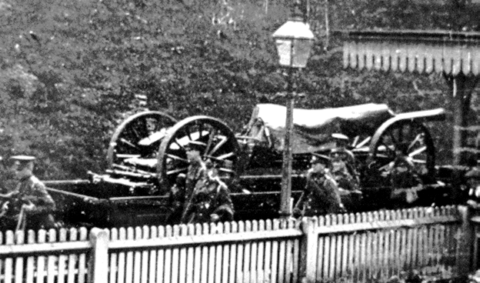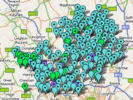The Council at War
Chapter 9
The Troops Arrive
The 1913 Army Manœuvres.
Major military manœuvres were carried out in September, 1913, and they were extensively reported in The Times and The Gazette. The exercise involved a supposed attack by Brownland, with its military headquarters at Watford, against Whiteland’s capital at Nuneaton. Brownland’s commander, Sir John French, dispatched an expeditionary force of four divisions of infantry and one of cavalry, involving some 47,000 men, 17,000 horses and 190 guns. As the purpose of the manœuvres was to exercise the staff control and support function of troops on the move, Whiteland only had a masked (dummy) force, although the majority of the 34 aeroplanes and 3 airships were allocated to it, so that it could spy out the movements of the attacking force. During the exercise about 20,000 men passed through the Hemel Hempstead area.
Immediately prior to the manœuvres motorists were warned “that the Uxbridge-Amersham-Great Missenden-Wendover road and the Watford-Hemel-Hempstead-Leighton Buzzard road will be occupied by troops on Saturday, 20th, and Sunday, 21st September. ... there will be considerable traffic of water carts, supply wagons, etc., on the roads on the above dates.” The Gazette records that on the Saturday morning “The streets echoed to the tramp of thousands of khaki-clad warriors ... The bright colouring of the tartans in the uniform of the Highlanders came as a welcome relief to the drab and dingy appearance of the rest, while the sound of music, the rattle of drums, the skirl of the pipes, and the singing of the men as they marched, added a note of cheerfulness to the scene. Following the men came innumerable baggage and transport wagons, batteries of artillery, ambulance wagons, ammunition and water carts.”
The 4th Division set up its headquarters at Hemel Hempstead on land belonging to Mr Grover adjacent to Randall Park. There were very large army camps on the Highfield Estate and along the old Redbourn Road, while some of the other camps were at Langleybury, Hazlewood, Shendish and Boxmoor to the south and Gaddesden Place, Hudnall and Dagnall to the north. There were 100 tents in the Park at Berkhamsted, more troops at Gossoms End, and at Tring. At the aeroplane station at Halton, where Mr Alfred de Rothchild supplemented the regimental rations. On the Sunday some big siege guns arrived at the Hemel Hempstead (Midland) Station, and were unloaded by a detachment of the Royal Garrison Artillery, using six-horse teams. Early on the Monday morning the troops started to move north, and the High Street was blocked to any other traffic until mid-day. By the afternoon most of the camp sites had been cleared.
 |
A 60 pounder gun of the 31st Heavy Battery, Royal Garrison Artillery at the Midland Station, Hemel Hempstead, September, 1913. In addition to the 60 pounder guns of the 31st Heavy Battery, the 4th Division was supported by the 14th, 29th and 32nd Brigades Royal Field Artillery equipped with 18 pounder field guns and the 37th Brigade R.F.A. with 4.5 inch howitzers. |
|
| August 2014 | Page Created |

